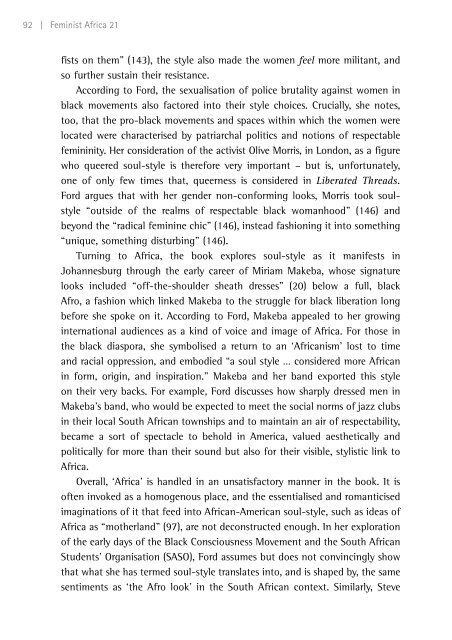The politics of fashion and beauty in Africa
fa21_proof_3
fa21_proof_3
Create successful ePaper yourself
Turn your PDF publications into a flip-book with our unique Google optimized e-Paper software.
92 | Fem<strong>in</strong>ist <strong>Africa</strong> 21<br />
fists on them” (143), the style also made the women feel more militant, <strong>and</strong><br />
so further susta<strong>in</strong> their resistance.<br />
Accord<strong>in</strong>g to Ford, the sexualisation <strong>of</strong> police brutality aga<strong>in</strong>st women <strong>in</strong><br />
black movements also factored <strong>in</strong>to their style choices. Crucially, she notes,<br />
too, that the pro-black movements <strong>and</strong> spaces with<strong>in</strong> which the women were<br />
located were characterised by patriarchal <strong>politics</strong> <strong>and</strong> notions <strong>of</strong> respectable<br />
fem<strong>in</strong><strong>in</strong>ity. Her consideration <strong>of</strong> the activist Olive Morris, <strong>in</strong> London, as a figure<br />
who queered soul-style is therefore very important – but is, unfortunately,<br />
one <strong>of</strong> only few times that, queerness is considered <strong>in</strong> Liberated Threads.<br />
Ford argues that with her gender non-conform<strong>in</strong>g looks, Morris took soulstyle<br />
“outside <strong>of</strong> the realms <strong>of</strong> respectable black womanhood” (146) <strong>and</strong><br />
beyond the “radical fem<strong>in</strong><strong>in</strong>e chic” (146), <strong>in</strong>stead <strong>fashion</strong><strong>in</strong>g it <strong>in</strong>to someth<strong>in</strong>g<br />
“unique, someth<strong>in</strong>g disturb<strong>in</strong>g” (146).<br />
Turn<strong>in</strong>g to <strong>Africa</strong>, the book explores soul-style as it manifests <strong>in</strong><br />
Johannesburg through the early career <strong>of</strong> Miriam Makeba, whose signature<br />
looks <strong>in</strong>cluded “<strong>of</strong>f-the-shoulder sheath dresses” (20) below a full, black<br />
Afro, a <strong>fashion</strong> which l<strong>in</strong>ked Makeba to the struggle for black liberation long<br />
before she spoke on it. Accord<strong>in</strong>g to Ford, Makeba appealed to her grow<strong>in</strong>g<br />
<strong>in</strong>ternational audiences as a k<strong>in</strong>d <strong>of</strong> voice <strong>and</strong> image <strong>of</strong> <strong>Africa</strong>. For those <strong>in</strong><br />
the black diaspora, she symbolised a return to an ‘<strong>Africa</strong>nism’ lost to time<br />
<strong>and</strong> racial oppression, <strong>and</strong> embodied “a soul style … considered more <strong>Africa</strong>n<br />
<strong>in</strong> form, orig<strong>in</strong>, <strong>and</strong> <strong>in</strong>spiration.” Makeba <strong>and</strong> her b<strong>and</strong> exported this style<br />
on their very backs. For example, Ford discusses how sharply dressed men <strong>in</strong><br />
Makeba’s b<strong>and</strong>, who would be expected to meet the social norms <strong>of</strong> jazz clubs<br />
<strong>in</strong> their local South <strong>Africa</strong>n townships <strong>and</strong> to ma<strong>in</strong>ta<strong>in</strong> an air <strong>of</strong> respectability,<br />
became a sort <strong>of</strong> spectacle to behold <strong>in</strong> America, valued aesthetically <strong>and</strong><br />
politically for more than their sound but also for their visible, stylistic l<strong>in</strong>k to<br />
<strong>Africa</strong>.<br />
Overall, ‘<strong>Africa</strong>’ is h<strong>and</strong>led <strong>in</strong> an unsatisfactory manner <strong>in</strong> the book. It is<br />
<strong>of</strong>ten <strong>in</strong>voked as a homogenous place, <strong>and</strong> the essentialised <strong>and</strong> romanticised<br />
imag<strong>in</strong>ations <strong>of</strong> it that feed <strong>in</strong>to <strong>Africa</strong>n-American soul-style, such as ideas <strong>of</strong><br />
<strong>Africa</strong> as “motherl<strong>and</strong>” (97), are not deconstructed enough. In her exploration<br />
<strong>of</strong> the early days <strong>of</strong> the Black Consciousness Movement <strong>and</strong> the South <strong>Africa</strong>n<br />
Students’ Organisation (SASO), Ford assumes but does not conv<strong>in</strong>c<strong>in</strong>gly show<br />
that what she has termed soul-style translates <strong>in</strong>to, <strong>and</strong> is shaped by, the same<br />
sentiments as ‘the Afro look’ <strong>in</strong> the South <strong>Africa</strong>n context. Similarly, Steve



